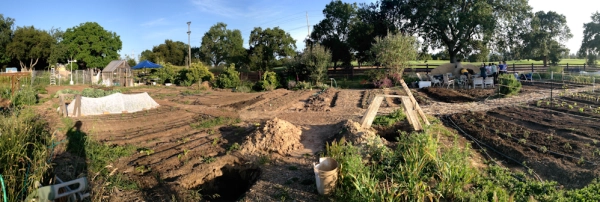In a project out of Stanford’s Zarelab, scientists Richard Zare, Xiaowei Song and Chanbasha Basheer discovered a new, eco-friendly chemical process that they say could transform how we create ammonia, the basis of the world’s most common fertilizer. In 2022, the global production of ammonia was around 150 million metric tons.
Ammonia (NH3), an inorganic compound of nitrogen and hydrogen, serves as the building block to create chemical fertilizers for agricultural crops. Around 70% of ammonia is used for fertilizers to aid in plant growth while the other 30% is primarily used for plastics, explosives and synthetic fibers.
For over 100 years, ammonia has been created with the Haber-Bosch process, which converts nitrogen into ammonia for fertilizers. The process uses around 2% of the world’s energy and contributes to 1.3% of global emissions of carbon dioxide each year, according to Richard Zare, the head of the Zarelab and the Marguerite Blake Wilbur Professor in Natural Science at Stanford.
“It is well recognized that the Haber-Bosch process is one of the most important industrial processes in chemistry. It’s after all what people use to feed the world,” Zare said. “People thought at the end of the 1800s that we were all going to starve ultimately because the population was growing faster than we could make plants to eat. What saved us was an amazing development by Fritz Haber who learned how to take nitrogen and turn it into ammonia.”
According to Zare, this process is energy intensive because the nitrogen molecule is quite inert, meaning it does not easily react with hydrogen to form the desired ammonia. The hydrogen atoms need to come from a source, and the Haber-Bosch process uses steam (H2O) to convert natural gas (methane, CH4) into H2 and CO, obtaining the hydrogen atoms. With more steam added, the CO is then converted into carbon dioxide (CO2), and more hydrogen atoms are generated.
This process is therefore a huge emitter of greenhouse gasses. Zare said it is estimated that 7% of global industrial CO2 emissions comes from the production of ammonia.
In Zare, Song and Basheer’s new process to create ammonia, the source of hydrogen is not methane but instead water, and as such, no carbon dioxide is emitted. Their process also involves no applied voltage, no irradiation by a light source and is conducted at room temperature and atmospheric pressure.
Their finding builds on recent research from the Zarelab that examines the high reactivity of water microdroplets. Bulk water tends to be benign and inert, but water droplets are highly reactive. According to Song, these microdroplets can be thought of as mist from a humidifier. “These are tiny properties,” he said.
Zare said the lab found that microdroplets of water produce a strong chemical reaction when hitting hard surfaces. To produce ammonia, the team of scientists break nitrogen bonds by moving water microdroplets, nitrogen gas and iron oxide through a gas-powered sprayer. The process relies on water microdroplets’ ability to react on hard surfaces.
The iron oxide serves as the catalyst for the reaction — accelerating the reaction without being changed by the reaction. The researchers put the catalyst in a graphite mesh for the sprayer. The sprayer then releases microdroplets, where the pumped water and nitrogen react with the help of the catalyst to form ammonia (NH3).
When the team found that they could create ammonia without CO2 they were excited, according to Song, but cautious.
“We had to be torturous about whether it was our expected result, and we needed to have many controls,” Song said.
“For this to be a big deal, it needs to be scaled up and demonstrated that all the steps involved make good economic sense,” Zare said. “We have not yet solved the problem — these are still little droplets we’re talking about.”
Zare said the next step for scaling this project is collaborating with engineers. He said the timeline to have ammonia at scale should take less than five years, but it will take at least one year. He added that the Haber-Bosch process took five years to finish.
“This is a key advance that can significantly enhance the sustainability of ammonia production if deployed at scale,” said Eric McShane, a post-doctoral scholar in chemical engineering with Stanford’s Cargnello Group. “Using water instead of hydrogen as a feedstock for ammonia production could reduce the overall energy requirement for ammonia production.”
McShane also agreed with the researchers that “the challenge is scaling their process and ensuring sufficiently high ammonia yield.”
“If it really works, it’s huge,” Zare said. “It would cut the cost of food, and it would help us in regard to climate change. It’s huge if it really can be done.”
